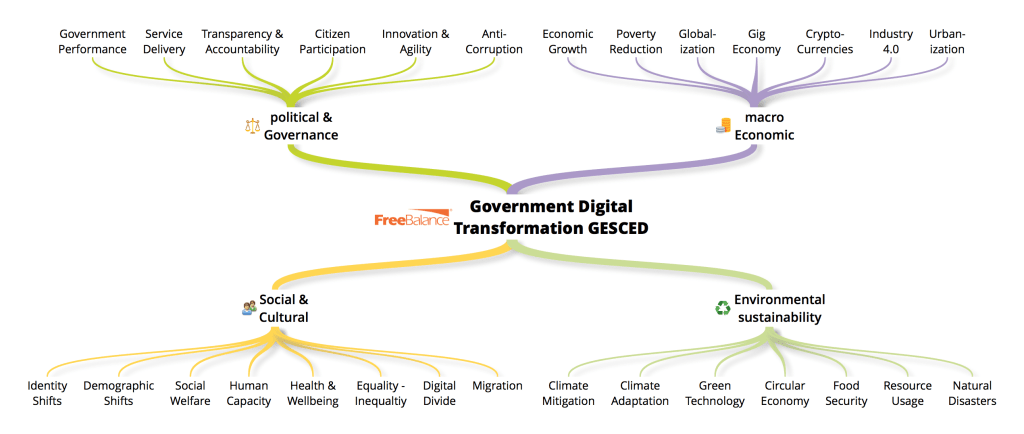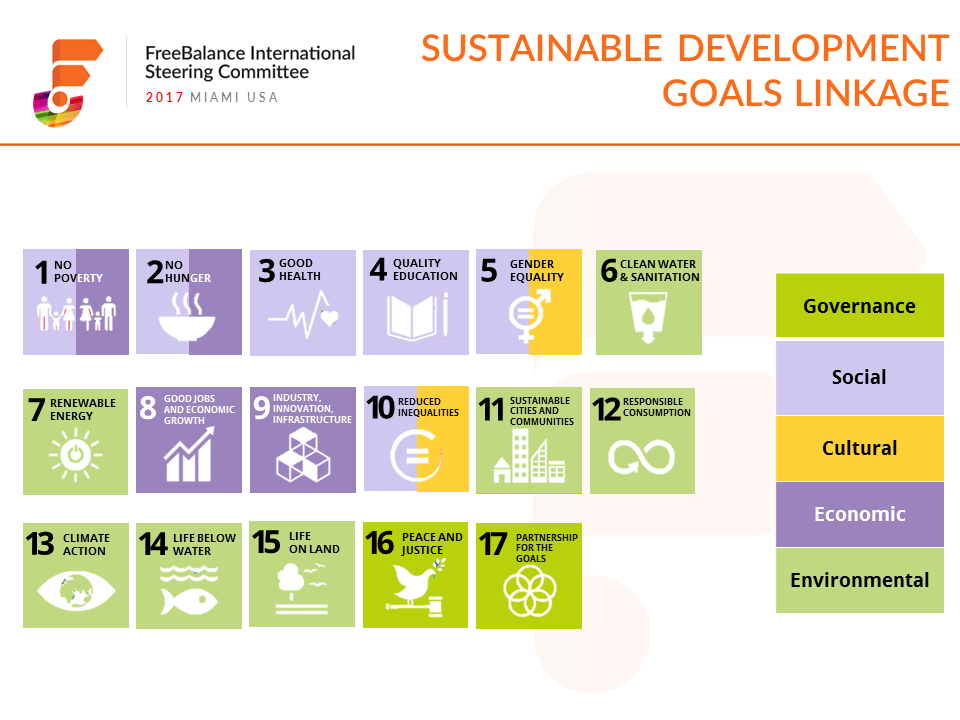Government digital transformation is much more than optimizing existing processes. It’s not about analog thinking, as described in the What is Digital Transformation blog post earlier this week. extent of organizational change required for government organizations to digitally transform seems overwhelming. Why do government leaders spearhead deep and disruptive organizational change? How does digital drive change?
Nexus of Wicked Problems
Government organizations are at the nexus of societal “wicked problems“, or “social mess“. The social mess, as described by Robert Horn, includes the following characteristics:
- No unique “correct” view of the problem
- Different views of the problem and contradictory solutions
- Most problems are connected to other problems
- Data are often uncertain or missing
- Multiple value conflicts
- Ideological and cultural constraints
- Political constraints
- Economic constraints
- Often a-logical illogical or multi-valued thinking
- Numerous possible intervention points
- Consequences difficult to imagine
- Considerable uncertainty, ambiguity
- Great resistance to change
- Problem solver out of contact with the problems and potential solutions
Governance Opportunity in Social Mess
The disruption of consumer and business markets by digital giants like Amazon, Apple and Google threatens public sector organizations. What is the place of government in the digital world? Institutions threatened with irrelevance seek out different perspectives. There’s nothing that represents a “wicked problem” more than the 17 global Sustainable Development Goals (SDGs). The SDGs are interrelated, providing governments with potential positive network effects. Where can government start?

Governance Implications
- Government Performance
- Context: Without a clear bottom line like profit in the private sector, governments struggle to improve outcomes. Meanwhile, deep stereotypes persist that government performance lags behind business. Government Effectiveness is one of the 6 World Governance Indicator sets covering areas such as bureaucratic effectiveness, sector effectiveness, public administration and financial management.
- Digital Challenge: Increasing adoption of mobile technology and social media exposes government performance limitations.
- Digital Opportunity: Integration between government information systems and social media outreach can provide insights to dramatically improve government results.
- Service Delivery
- Context: Government services are stretched in many countries. Government Effectiveness, one of the 6 World Governance Indicator sets, has some sector service delivery quality measures.
- Digital Challenge: Citizen expectations for services have increased because of consumer digital experiences.
- Digital Opportunity: Governments can leverage digital technologies, process reform, user experience (UX), customer experience (CX), and design thinking to dramatically improve citizen services.
- Transparency & Accountability
- Context: The Edelman Trust Barometer finds that governments are trusted less than businesses, media and non-profits. “Develop effective, accountable and transparent institutions at all levels” is a goal for SDG16: Peace, Justice and strong institutions. Voice and Accountability is one of the 6 World Governance Indicator sets that include human rights, accountability, press freedom, and electoral process.
- Digital Challenge: Suspicion about political agenda and corruption is amplified through social media, and ‘fake news’. Persistent suspicion leads to social unrest and conflict, much like the ‘Arab Spring
- Digital Opportunity: Fiscal transparency through digital portals, and accountability mechanisms including audit and anti-corruption efforts increase trust in government.
- Citizen Participation
- Context: Narrow political participation to elites. “Ensure responsive, inclusive, participatory and representative decision-making at all levels” is a goal for SDG16: Peace, Justice and strong institutions.
- Digital Challenge: The pluralist viewpoint that policy should be left to experts and elites clashes with the viewpoint that elites have lost touch, and experts have led to failures.
- Digital Opportunity: Efficient and effective methods to engage external experts, engaged citizens, and those closest to problems to improve problem-solving and performance audit.
- Innovation & Agility
- Context: Long cycles, waterfall implementations in government.
- Digital Challenge: Failure of large IT projects by established vendors using conservative procurement strategies, such as the Government of Canada’s ‘Phoenix Pay System’, leads to the view that newer technologies are riskier.
- Digital Opportunity: Small technology experiments using agile procurement and lean techniques manage risk better than traditional methods.
- Anti-Corruption
- Context: Anti-corruption initiatives function well when including whistle-blower protection, independent investigations, with financial and systems audits to optimize government spending. $2.6 Trillion is the estimated annual cost of corruption, where “corruption, bribery, theft and tax evasion cost some US $1.26 trillion for developing countries.” Anti-corruption is a major focus for SDG16: Peace, Justice and strong institutions. Control of Corruption is one of the 6 World Governance Indicator sets.
- Digital Challenge: Digital technology provides new corruption and fraud opportunities when not properly implemented.
- Digital Opportunity: Good information security policies, with segregation of duties, distributed ledgers, electronic payments, and integrated digital controls automating anti-corruption protection.
Economic Implications
- Economic Growth
- Context: Economic growth is a key objective for government policy. Nevertheless, “nearly 2.2 billion people live below the US$2 poverty line and that poverty eradication is only possible through stable and well-paid jobs.” This is the focus of SDG8: Decent work and economic growth. Inadequate infrastructure, known as the infrastructure gap, “leads to a lack of access to markets, jobs, information and training, creating a major barrier to doing business.” This is a focus of SDG9: Industry, innovation and infrastructure.
- Digital Challenge: The combination of government debt, lack of financing, and inability to maintain existing infrastructure creates under-investment in social and physical infrastructure, despite clear evidence of significant returns.
- Digital Opportunity: Digital technology can be used for monitoring infrastructure returns while using smart devices for preventative maintenance to reduce costs.
- Poverty Reduction
- Context: Statistics show the pattern of poverty reduction over the past decades, particularly in extreme poverty. Nevertheless, there are problems associated with these statistics. And, “767 million people live below the international poverty line of $1.90 a day.” This is the theme for SDG1: Poverty.
- Digital Challenge: Poverty reduction requires complex policy intervention that conflicts with economic liberalization. Poverty policies elicit dogmatic debates between right and left.
- Digital Opportunity: Big data analytics promises to modernize policy from dogma to data by determining what works in context.
- Globalization
- Context: Economies are becoming more integrated. This integration disrupts vested interests and can be to the detriment of the poor.
- Digital Challenge: Protectionism restricts growth. Yet, there are losers in free trade.
- Digital Opportunity: Globalization is a reality. Governments can use big data to track trade and growth. Investment in the right industries protects countries and supports growth. Digital can help policy-makers to navigate the Atlas of Economic Complexity.
- Gig Economy – digitally-driven
- Context: There is an increase in employment in the so-called “gig economy” that includes freelancing and the use of “platforms” such as Uber and Airbnb.
- Digital Challenge: Negative characteristics of the current gig or “platform economy” providers include low pay, poor job security, limited job benefits, tax avoidance, and the use of technology to skirt legal requirements such as the Uber Greyball program. Meanwhile, established businesses that pay taxes and provide benefits are at a disadvantage.
- Digital Opportunity: The gig economy is an opportunity for governments to support innovation that improves economic value, and reduces waste through sharing. Data-driven policy can inform regulation to create the optimal level of social support.
- Cryptocurrencies – digitally-driven
- Context: Bitcoin and other cryptocurrencies using blockchain technologies, on a peer-to-peer basis, promise to reduce transaction costs while functioning without the need for central trusted authorities like financial institutions. The recent financial crisis showed that many financial institutions were not trustworthy.
- Digital Challenge: Cryptocurrencies are often used for illegal activities. Investors using Initial Coin Offerings (ICO) skirt securities law. Exchanges have proven susceptible to failure. Transaction costs have not been eliminated. Wild speculation on cryptocurrencies makes for economic uncertainty.
- Digital Opportunity: There’s more to blockchain and distributed ledgers than cryptocurrencies. Experiments show how blockchain technology can be leveraged for smart contracts, remittances, international aid, and copyright protection. Most importantly, blockchain can act as a major anti-corruption mechanism through transaction immutability.
- Industry 4.0 – digitally-driven
- Context: The combination of “cyber-physical systems, the Internet of things, cloud computing and cognitive computing,” promises unprecedented industrial and manufacturing productivity.
- Digital Challenge: Analysts differ in their assessment of Industry 4.0 effects. Some see massive unemployment, while others see job shifts with net increases in jobs. The challenge to governments is far greater. New digital skills are needed where current educational curricula have become out-of-date. The use of artificial intelligence, robotics and 3D printing overcome labour arbitrage creating massive unemployment in countries with low-cost workforces.
- Digital Opportunity: Governments can fund industry 4.0 investments, and leverage digital for workforce capacity building.
- Urbanization
- Context: “By 2030, almost 60 percent of the world’s population will live in urban areas.” The number of megacities, with populations exceeding 10 million, is expected to rise from 28 in 2014 to 41 in 2030. This is the focus of SDG11: Sustainable Cities and Communities.
- Digital Challenge: Rapid population growth can result in large slums, poverty increases, conflict, high resource consumption, sanitation and health issues.
- Digital Opportunity: Smart city technologies, with effective planning, and urban innovation can create sustainable urbanization.
Social and Cultural Implications
- Identity Shifts
- Context: Economist Amartya Sen has identified the link between identity and conflict. Marshall McLuhan identified violence as a quest for identity.
- Digital Challenge: Social media amplifies identity differences among people. National, ethnic, and religious identity is creating conflict.
- Digital Opportunity: Social media could amplify understanding and transnationalism.
- Demographic Shifts
- Context: People are living longer, and having fewer children.
- Digital Challenge: The burden of social entitlement costs for workers threatens to increase, with fewer workers supporting more pensioners. For example, Japan is witnessing a shrinking population “contributing to a ballooning public debt and starving the economy of labour.”
- Digital Opportunity: Industry 4.0 technologies like artificial intelligence, 3D printing, robotics, and self-driving vehicles promise to augment worker productivity and generate prosperity. On, the other hand, as described above, Industry 4.0 requires significant shifts in worker skills.
- Social Welfare
- Context: Social services provided by governments are under financial threat globally. Some believe that social programs create negative incentives, and increase taxes. Others see the correlation between high taxes, excellent social programs, and high satisfaction with government in Scandinavian countries.
- Digital Challenge: Cuts in social welfare, particularly in employment investments like retraining, have serious mental health and poverty implications.
- Digital Opportunity: a
- Human Capacity
- Context: Although “basic literacy skills have improved tremendously, …bolder efforts are needed to make even greater strides for achieving universal education goals…103 million youth worldwide lack basic literacy skills.” This is a focus for SDG4: Quality education.
- Digital Challenge: The Human Development Index that rates Country knowledge, life expectancy and quality of living, demonstrates a vast divide between rich and poor countries. The increasing complexity of digital tools for work, especially Industry 4.0, has created a “war for talent.” This trend threatens to extend the economic disadvantages in poor countries.
- Digital Opportunity: Innovations in e-learning including Massive Open Online Courses (MOOCs) and just-in-time training, product usability or User Experience (UX) including the shift to voice and visual interfaces promise to overcome human capacity challenges.
- Health & Wellbeing
- Context: Economic policy focused on growth often translates to low life satisfaction, well-being and happiness. This is why Bhutan created the Gross National Happiness Index, as an alternative to Gross Domestic Product (GDP). Health is the focus of SDG3: Health and wellbeing.
- Digital Challenge: Traditional dogma for GDP growth and market liberalization can create broader inequity while delivering outcomes that are not perceived as important by citizens.
- Digital Opportunity: The use of data analysis, sentiment analysis, and citizen participation through digital tools can align government policy with citizen priorities. Citizen nudges can improve health outcomes.
- Equality – Inequality
- Context: There is increasing income inequality in many countries creating a wider divide between rich and poor. “Income inequality increased by 11 percent in developing countries between 1990 and 2010.” There is also inequity in opportunity by groups. This is a focus for SDG10: Reduced inequality. SDG5: Gender equality is also relevant.
- Digital Challenge: Digital innovation and new business models threaten to extend the income divide. Fortunes are built on technology and small labour forces.
- Digital Opportunity: Digital technology can be leveraged to improve equity through education, and access to information. Governments can use rich data to deliver programs to improve equity. “Several countries have managed to contain or reduce income inequality while achieving strong growth performance.”
- Digital Divide – digitally-driven
- Context: There is a digital divide between rich and poor, even in the era of widespread smartphone adoption.
- Digital Challenge: Although the U.N. found that there are more cell phones than working toilets worldwide, digital fluency, bandwidth, and device functionality threaten to broaden the digital divide. This divide can extend the social and economic advantages for the more affluent.
- Digital Opportunity: The notion of internet access as a human right is gaining acceptance. Innovation is driving costs lower making universal internet access realistic. Digital, by itself, cannot close this divide. ICT4D (Information and Communications Technology for Development) has positive results when integrated with supporting policies, and is deployed based on the social and cultural context.
- Migration
- Context: Migration from rich to poor countries has reached crisis levels. Remittances, estimated at $.5T annually, have become an important source of income in developing countries.
- Digital Challenge: The widening income gap between rich and poor countries is driving increases in illegal immigration. Many affluent countries witness cultural clashes and political crises.
- Digital Opportunity: Digital technology to help overcome basic economic problems in developing countries can lessen the motivation for migration. Digital education for migrants can reduce culture clashes. The expertise acquired in developed countries instigates the reverse brain drain when migrants return to their home countries.
Environmental Implications
- Climate Mitigation
- Context: Climate concerns drive many of the SDGs, including SDG6: Clean water and sanitation, SDG13: Climate action, SDG14: Life below water and SDG15: Life on land. Almost all countries have ratified the Paris Agreement “to strengthen the global response to the threat of climate change by keeping a global temperature rise this century well below 2 degrees Celsius above pre-industrial levels and to pursue efforts to limit the temperature increase even further to 1.5 degrees Celsius.”
- Digital Challenge: The majority of scientists believe that economic growth leads to climate change. And, digital technology enables “climate deniers.”
- Digital Opportunity: Data-driven analysis of complex data can lead to innovative methods to reduce the climate impact of growth.
- Climate Adaptation
- Context: The increase in extreme climate events means that governments need to adapt to the new reality.
- Digital Challenge: Infrastructure is crumbling in an era of an increasing infrastructure gap of Trillions of Dollars.
- Digital Opportunity: Digital technology can improve climate adaptation planning through data-driven decisions. And, digital technology such as Internet of Things (IoT) devices can track extreme climate events, and monitor infrastructure effectiveness.
- Green Technology
- Context: “Energy is the dominant contributor to climate change, accounting for around 60 percent of total global greenhouse gas emissions.” Many countries are dependent on these sources of energy. SDG7: Affordable and clean energy focuses on renewable and energy-efficient technologies.
- Digital Challenge: As emerging economies grow, citizens demand more comfortable lifestyles, consuming more resources.
- Digital Opportunity: Digital technologies have become more energy efficient. Renewable energy sources like wind, wave and solar power have also become more efficient. Smart technologies can optimize energy and resource use.
- Circular Economy
- Context: Consumption leads to waste. The circular economy seeks to get beyond traditional “take, make and dispose.”
- Digital Challenge: Growth often leads to more waste. And, digital devices become rapidly obsolete: smartphones, tablets, fitness trackers, smart watches, PCs, and TVs fill landfills.
- Digital Opportunity: Digital tracking from manufacturing to end-of-life enables companies to recycle and reuse. The government can encourage this supply chain through regulation and incentives.
- Food Security
- Context: “Globally, one in nine people in the world today (795 million) are undernourished.” Famines have become commonplace, and many countries lack reliable and sustainable food production. Food security is a major theme for SDG2: Hunger and food security.
- Digital Challenge: Population growth, urbanization, food waste, monocultures, natural disasters, extreme weather events, and resource and land depletion threaten food security. Obesity has become an epidemic in affluent countries.
- Digital Opportunity: Digital technology enables smart agriculture for more effective farming. Technology innovations for reducing food waste, improving recycling and nudging citizens to healthy eating are part of the food security solution.
- Resource Usage
- Context: “Should the global population reach 9.6 billion by 2050, the equivalent of almost three planets could be required to provide the natural resources needed to sustain current lifestyles“. This is the focus of SDG12: Responsible consumption and production.
- Digital Challenge: Growth has been traditionally associated with resource depletion. Digital hardware is built using scarce resources and heavy metals.
- Digital Opportunity: Innovative
- Natural Disasters
- Context: Increasing rate of natural disasters, such as extreme weather events threaten livelihoods, particularly the poor.
- Digital Challenge: Government silos make holistic planning difficult.
- Digital Opportunity: Investment in digital warning systems through effective comprehensive program budgeting improves country disaster resilience. Digital systems, linked with mobile social networks, can mitigate the impact of natural disasters.
Policy-makers use the GESCED to SDGs alignment in long-term planning and program prioritization.

